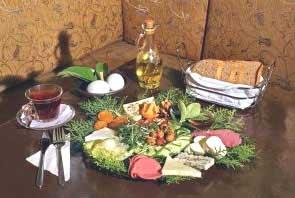

Cuisine
Types
In Friland a distinction is made between the traditional Frilandic cuisine ("arb■auwalika Frilandiska ailidhus"), foreign cuisines ("utanlandiska ailidhusan") and a Frilandic mixed cuisine ("Frilandiska nustailidhus"), which is a combination of both.
Popular foreign cuisines are the French, Italian, Indonesian and Chinese. The Frilandic mixed cuisine consists of both Frilandic and exotic dishes, which are often supplemented with eachothers ingredients. Examples are a typically Frilandic fish dish that is flavoured with Eastern herbs and noodles or Italian tortellini combined with Hunaggron ("Honey-green"), a Frilandic dish with honey and steamed vegetables.
The Frilandic cuisine
 An extensive meal usually consists of a first course or soup, a main course and dessert. When it comes to flavour the first two courses are usually salty and the last one is sweet.
An extensive meal usually consists of a first course or soup, a main course and dessert. When it comes to flavour the first two courses are usually salty and the last one is sweet.
Most Frilandic dishes contain bread, fish, poultry, dairy, vegetables or a combination thereof. Rice and potatoes are usually also added to this, which may originally be from Asia and America but have become a fully accepted part of the traditional kitchen these days. Puristic cooks sometimes prefer to use only native ingredients but on the average Frilandic dinner table potatoes and rice have become common. Baking in olive oil (Mediterranean in origin) also largely replaced baking in gravy and has become and important part of the traditional cuisine. Many cooks don't even use gravy at all anymore because olive oil is healthier. By the way, the most usual methods of preparation in the Frilandic kitchen are boiling and stir-frying.
Side dishes
Popular alcoholic drinks are mainly beer and mead; wine is used less. The most well-known brands are Stolburg alu■ (Stolburg beer), Landsberg and Kolamed (Cool mead).
Chocolate is very popular, especially the so-called "brunstubwurman" (chocolate worms), which look a bit like sticks of rock.
Snacks like French fries and hamburgers are eaten with moderation in Friland: once a week most families hold a so-called "Amerikaniska faretdag" (American munching day), on which the local snackbar or McDonalds provide the food.
Health
Many Frilanders prefer to eat biologic food. The so-called "light" products with unhealthy ingredients like aspartame and saccharin are being avoided and there are also strict regulations for poisons and dioxin. Meat is seen as a healthy addition to the meal but is eaten with moderation. There are also extensive laws to prevent unnecessary animal suffering and holding boxed calves, battery cages, boiling lobsters alive and adding hormones to the animal fodder is forbidden.
Recipy: Saltaswaips ("Salad wraps")
(No amounts are given for the ingredients because these depend on the number of saltaswaips that have to be made)
Needed:
walnuts (alternatively: pecan nuts)
cashew nuts
peanuts
chicken (alternatively: salmon)
lettuce
carrots
celery
cucumber
tomatoes
paprika
strawberries/apricots/pineapple/bilberries (pick one of four)
apples
raisins
swaips
NB: swaips are unleavened pancakes that are almost exclusively sold at Frilandic supermarkets like WG (Waldmers Grautmerkat). As an alternative you can use tortillas because these have strong similarities with swaips.
Preparation:
Cut the carrots, tomatoes and the fruits you have chosen (strawberries, apricots, pineapple or bilberries) into pieces.
Cut the cucumber, paprika and apples into little blocks.
Stir-fry the chicken (alternatively: salmon) until it's done and cut it into little pieces.
Throw everything into one big bowl and add the celery, lettuce, raisins, walnuts/pecan nuts, cashew nuts and peanuts.
Heat the swaips, put some salad on them and wrap them up.
Et ■u smaklik! (Enjoy your meal!)

|